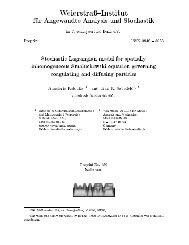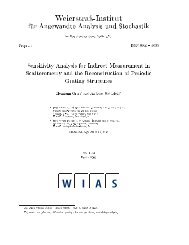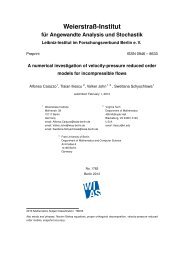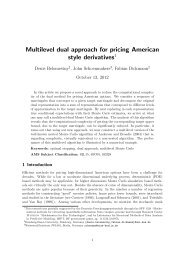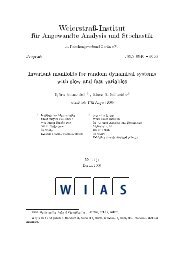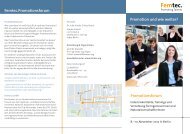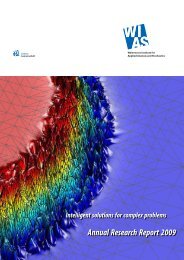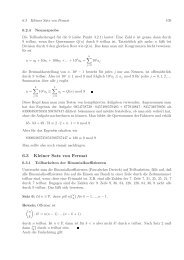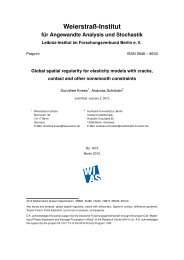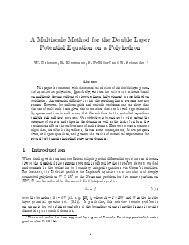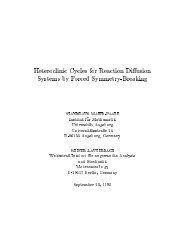PDF (5143 kByte) - WIAS
PDF (5143 kByte) - WIAS
PDF (5143 kByte) - WIAS
Create successful ePaper yourself
Turn your PDF publications into a flip-book with our unique Google optimized e-Paper software.
the aggregated information on the homogeneity regions is used to obtain improved estimates<br />
for the image values ESg, using kernel estimation. These estimates are then again used to<br />
infer on the homogeneity regions.<br />
The estimate for the image value ESg1 at g1 ∈ R 3 ⋊ S 2 and iteration step k is<br />
(2)<br />
ˆ S (k)<br />
g1 := <br />
g2∈R 3 ⋊S 2<br />
w (k) (k)<br />
g1g2Sg2/N g1<br />
with N (k)<br />
g1 := <br />
g2 w(k) g1g2 and local weighting schemes w (k)<br />
g1g2 for each pair of measurements at<br />
g1, g2 ∈ R 3 ⋊ S 2 :<br />
(3) w (k)<br />
g1g2 := Kloc<br />
<br />
∆κ( b1,k) (g1, g2) /h( (k)<br />
b1, k) Kst s g1g2 /λ .<br />
We call the weights w (k)<br />
g1g2 adaptive. We use the term non-adaptive if the factor Kst(s (k)<br />
g1g2/λ)<br />
is omitted in Eq. (3). In Figure 2 we show the non-adaptive weighting schemes for several<br />
bandwidths and values of κ in order to demonstrate effects of the discrepancy function ∆κ.<br />
Now, we shortly describe the terms used in Eq. (3):<br />
Kloc and Kst are kernel functions.<br />
∆κ (g1, g2) is the discrepancy introduced above.<br />
{h( b, k)}k=0,··· ,k∗ is an increasing sequence of bandwidths depending on the gradient<br />
directionb ∈ S2 .<br />
The sequence {κ( b, k)}k=0,··· ,k∗ describes for each gradient directionb ∈ S2 the relation<br />
between distances on the sphere and in voxel space.<br />
The statistical penalty s (k)<br />
g1g2, defined by<br />
<br />
ˆS (k−1)<br />
s (k) (k−1)<br />
g1g2 := N g1 · K<br />
g1<br />
ˆσ , ˆ S (k−1)<br />
g2<br />
ˆσ<br />
depends on the Kullback-Leibler distance between the two standardized Rician distribu-<br />
tions in g1 and g2 with parameters ˆ S (k−1)<br />
g1<br />
,<br />
/ˆσ and ˆ S (k−1)<br />
g1 /ˆσ, where ˆσ denotes an esti-<br />
mate for the scale parameter of the Rician distribution. Evaluating the distance between<br />
the estimated image values the statistical penalty tests for our structural assumption. The<br />
Kullback-Leibler distance is approximated numerically. N (k)<br />
g<br />
variance reduction at step k.<br />
λ is the adaptation parameter of the algorithm.<br />
5<br />
is an approximation for the<br />
Note that both, the sequence of bandwidths {h( b, k)}k=0,··· ,k∗ and the sequence of balancing<br />
parameters {κ( b, k)}k=0,··· ,k∗ possibly depend on the diffusion gradient direction b ∈ S2 , as<br />
most gradient schemes are not fully homogeneous on the sphere.<br />
Starting at very local initial estimates that coincide with non-adaptive-smoothing on the sphere,<br />
i.e. setting s (0)<br />
g1g2 := 1 and choosing h( bl, 0) = 1, and using the discrepancy derived in the<br />
previous section we iterate computation of weights (3) and estimation of ESg by ˆ S (k)<br />
g (2), increasing<br />
k with each iteration. This defines a position-orientation adaptive smoothing algorithm<br />
for diffusion weighted data in the space R3 ⋊ S2 .




